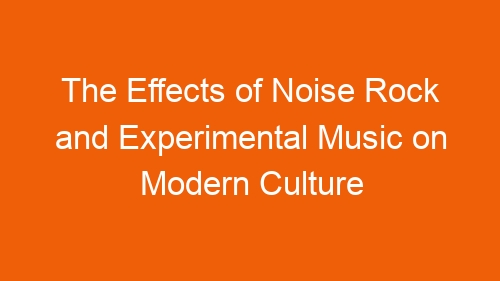-
Table of Contents
The Evolution of Noise Rock and Experimental Music in Contemporary Society
Noise rock and experimental music have long been considered fringe genres in the music world, often pushing the boundaries of traditional musical structures and challenging listeners with their unconventional sounds. However, in recent years, these genres have begun to gain more mainstream recognition and influence in modern culture. This article will explore the evolution of noise rock and experimental music in contemporary society and the effects they have had on the music industry and beyond.
Noise rock emerged in the late 1970s and early 1980s as a subgenre of alternative rock, characterized by its abrasive, dissonant sound and chaotic, often confrontational performances. Bands like Sonic Youth, Swans, and Big Black were pioneers of the genre, incorporating elements of punk, post-punk, and avant-garde music to create a unique and challenging sonic experience. Experimental music, on the other hand, encompasses a wide range of genres and styles that push the boundaries of traditional musical conventions, often incorporating elements of noise, electronic, and avant-garde music.
One of the key characteristics of noise rock and experimental music is their rejection of mainstream commercialism and conformity. These genres prioritize artistic expression and creativity over commercial success, often creating music that is challenging and confrontational. This rejection of mainstream norms has allowed noise rock and experimental music to thrive in underground music scenes and alternative music communities, where artists are free to explore new sounds and ideas without the pressure to conform to industry standards.
In recent years, noise rock and experimental music have begun to influence mainstream music and culture in significant ways. Artists like Radiohead, Bjork, and Animal Collective have incorporated elements of noise rock and experimental music into their music, creating a new wave of experimental pop that has gained widespread critical acclaim and commercial success. This crossover between underground and mainstream music has helped to bring noise rock and experimental music to a wider audience and has challenged traditional notions of what constitutes popular music.
The influence of noise rock and experimental music can also be seen in other areas of contemporary culture, such as film, art, and fashion. Filmmakers like David Lynch and Harmony Korine have used experimental music in their soundtracks to create a sense of unease and disorientation, while artists like Yayoi Kusama and Matthew Barney have drawn inspiration from noise rock aesthetics in their visual art. In fashion, designers like Rick Owens and Raf Simons have incorporated elements of noise rock and experimental music into their collections, creating a new wave of avant-garde fashion that challenges traditional notions of beauty and style.
Overall, the effects of noise rock and experimental music on modern culture are far-reaching and profound. These genres have challenged traditional musical conventions, influenced mainstream music and culture, and inspired a new wave of creativity and innovation in the arts. As noise rock and experimental music continue to evolve and push the boundaries of what is possible in music, it is clear that their impact on contemporary society will only continue to grow.
The Influence of Noise Rock and Experimental Music on Fashion and Art
Noise rock and experimental music have long been associated with pushing boundaries and challenging traditional norms in the music industry. However, their influence extends far beyond just the realm of music. In fact, noise rock and experimental music have had a significant impact on modern culture, particularly in the worlds of fashion and art.
One of the most notable ways in which noise rock and experimental music have influenced fashion is through their emphasis on individuality and self-expression. The DIY ethos that is often associated with these genres has inspired a new wave of designers and fashionistas to create their own unique looks and styles. This can be seen in the rise of streetwear brands that draw inspiration from the raw, edgy aesthetic of noise rock and experimental music.
Additionally, the bold and unconventional nature of noise rock and experimental music has also influenced the way in which fashion is presented and marketed. Many designers and brands now use avant-garde music and visuals in their runway shows and advertising campaigns, creating a sense of rebellion and nonconformity that resonates with fans of these genres.
In the world of art, noise rock and experimental music have also had a profound impact. Many artists have drawn inspiration from the chaotic and dissonant sounds of these genres, using them as a source of creative energy and inspiration. This can be seen in the rise of multimedia art installations that incorporate elements of noise rock and experimental music, creating immersive experiences that challenge the senses and push the boundaries of traditional art forms.
Furthermore, noise rock and experimental music have also influenced the way in which art is consumed and experienced. Many galleries and museums now host live performances and events that feature experimental musicians and artists, blurring the lines between music and visual art. This has created a new wave of interdisciplinary collaborations that push the boundaries of what is considered art.
Overall, the influence of noise rock and experimental music on fashion and art cannot be understated. These genres have inspired a new wave of creativity and innovation, challenging traditional norms and pushing the boundaries of what is considered mainstream. As we continue to see the impact of noise rock and experimental music on modern culture, it is clear that these genres will continue to shape the way we think about fashion, art, and creativity for years to come.
The Impact of Noise Rock and Experimental Music on Mental Health and Well-being
Noise rock and experimental music have long been considered niche genres, often associated with avant-garde artists and underground scenes. However, in recent years, these genres have started to gain more mainstream recognition and influence in modern culture. One area where their impact is particularly noteworthy is in the realm of mental health and well-being.
The chaotic and dissonant nature of noise rock and experimental music can be polarizing for listeners. Some find it exhilarating and cathartic, while others may find it overwhelming and anxiety-inducing. However, research has shown that exposure to these genres can have a range of effects on mental health and well-being.
One of the key benefits of noise rock and experimental music is its ability to provide an outlet for emotional expression. The raw and abrasive sounds can evoke a wide range of emotions, from anger and frustration to euphoria and transcendence. For many listeners, this can be a powerful form of release, allowing them to process and confront their innermost feelings in a safe and controlled environment.
Moreover, the unpredictable and unconventional nature of noise rock and experimental music can also stimulate creativity and imagination. By challenging traditional notions of melody, harmony, and structure, these genres encourage listeners to think outside the box and explore new sonic possibilities. This can be particularly beneficial for individuals struggling with creative blocks or seeking inspiration in their artistic pursuits.
In addition, the intense and immersive nature of noise rock and experimental music can also have a meditative effect on the mind. The relentless barrage of sound can induce a state of trance-like concentration, helping listeners to focus their thoughts and block out distractions. This can be especially helpful for individuals dealing with stress, anxiety, or other mental health issues, providing a temporary escape from the pressures of everyday life.
However, it is important to note that the effects of noise rock and experimental music on mental health and well-being can vary greatly from person to person. While some may find solace and comfort in the chaos, others may find it overwhelming and distressing. It is crucial for individuals to listen to their own needs and boundaries, and to seek professional help if they are struggling with their mental health.
Overall, the impact of noise rock and experimental music on modern culture is undeniable. From providing a platform for emotional expression to stimulating creativity and fostering a sense of mindfulness, these genres have the power to shape our perceptions and experiences in profound ways. As they continue to evolve and push the boundaries of sonic experimentation, it will be fascinating to see how they continue to influence our mental health and well-being in the years to come.




















